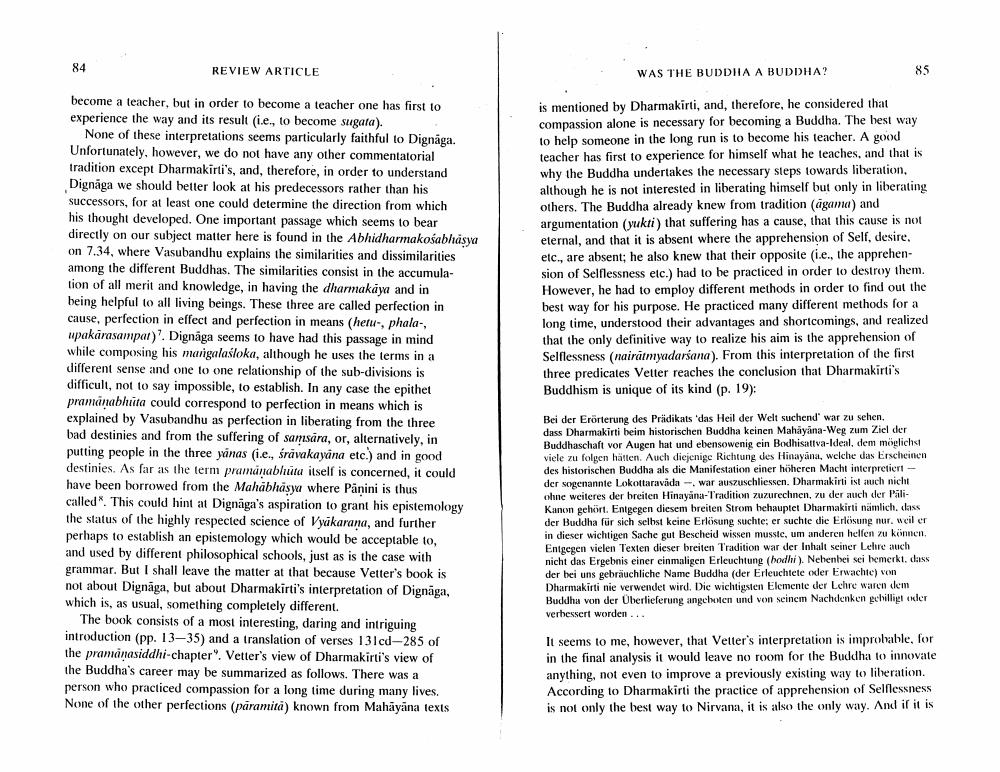Book Title: was The Buddha A Buddha Author(s): Eli Franco Publisher: Eli Franco View full book textPage 3
________________ 84 REVIEW ARTICLE WAS THE BUDDHA A BUDDHA? 85 is mentioned by Dharmakirti, and, therefore, he considered that compassion alone is necessary for becoming a Buddha. The best way to help someone in the long run is to become his teacher. A good teacher has first to experience for himself what he teaches, and that is why the Buddha undertakes the necessary steps towards liberation, although he is not interested in liberating himself but only in liberating others. The Buddha already knew from tradition (agama) and argumentation (yukti) that suffering has a cause, that this cause is not eternal, and that it is absent where the apprehension of Self, desire, etc., are absent; he also knew that their opposite (i.e., the apprehension of Selflessness etc.) had to be practiced in order to destroy them. However, he had to employ different methods in order to find out the best way for his purpose. He practiced many different methods for a long time, understood their advantages and shortcomings, and realized that the only definitive way to realize his aim is the apprehension of Selflessness (nairátmiyudarśana). From this interpretation of the first three predicates Vetter reaches the conclusion that Dharmakirtis Buddhism is unique of its kind (p. 19): become a teacher, but in order to become a teacher one has first to experience the way and its result i.e., to become sugata). None of these interpretations seems particularly faithful to Dignaga. Unfortunately, however, we do not have any other commentatorial tradition except Dharmakirti's, and, therefore, in order to understand Dignaga we should better look at his predecessors rather than his successors, for at least one could determine the direction from which his thought developed. One important passage which seems to bear directly on our subject matter here is found in the Abhidharmakośabhasya on 7.34, where Vasubandhu explains the similarities and dissimilarities among the different Buddhas. The similarities consist in the accumulation of all merit and knowledge, in having the dharmakaya and in being helpful to all living beings. These three are called perfection in cause, perfection in effect and perfection in means (hetu, phala, wpakarasampar). Dignāga seems to have had this passage in mind while composing his marigalasloka, although he uses the terms in a different sense and one to one relationship of the sub-divisions is difficult, not to say impossible, to establish. In any case the epithet priminabhita could correspond to perfection in means which is explained by Vasubandhu as perfection in liberating from the three bad destinies and from the suffering of sarisara, or, alternatively, in putting people in the three yanas i.e., śråvakayina etc.) and in good destinies. As far as the term pramanabhulu itself is concerned, it could have been borrowed from the Mahabhasya where Panini is thus called. This could hint at Dignaga's aspiration to grant his epistemology the status of the highly respected science of Vyakarana, and further perhaps to establish an epistemology which would be acceptable to, and used by different philosophical schools, just as is the case with grammar. But I shall leave the matter at that because Vetter's book is not about Dignāga, but about Dharmakirti's interpretation of Dignāga, which is, as usual, something completely different The book consists of a most interesting, daring and intriguing introduction (pp. 13–35) and a translation of verses 131cd-285 of the pramanasiddhi-chapter". Vetter's view of Dharmakirti's view of the Buddha's career may be summarized as follows. There was a person who practiced compassion for a long time during many lives. None of the other perfections (paramita) known from Mahayana texts Bei der Erörterung des Prlidikals das Heil der Welt suchend' war zu sehen. dass Dharmakirti beim historischen Buddha keinen Mahayana-Weg zum Ziel der Buddhaschaft vor Augen hat und ebensowenig ein Bodhisattva-Ideal, dem möglichst viele zu folgen hätten. Auch diejenige Richtung des Hinayana, welche das Erscheinen des historischen Buddha als die Manifestation einer höheren Macht interpretiert - der sogenannte Lokottaravida . war auszuschliessen. Dharmakirti ist auch nicht ohne weiteres der breiten Hinayana-Tradition zuzurechnen, zu der auch der PaliKanon gehört. Entgegen diesem breiten Strom hehauptet Dharmakirti nämlich, dass der Buddha für sich selbst keine Erlösung suchte, er suchte die Erlisung nur, weil er in dieser wichtigen Sache gut Bescheid wissen musste, um anderen helfen zu können, Entgegen vielen Texten dieser breiten Tradition war der Inhalt seiner Lehre auch nicht das Ergebnis einer einmaligen Erleuchtung (hodhi). Nehenbei sei bemerkt, dass der bei uns gebräuchliche Name Buddha (der Erleuchtete oder Erwachtc) von Dharmakirti nie verwendet wird. Die wichtigsten Elemente der Lehre waren dem Buddha von der Oberlieferung angchen und von seinem Nachdenken pilligt indler verbessert worden... It seems to me, however, that Vetter's interpretation is improbable, for in the final analysis it would leave no room for the Buddha to innovate anything, not even to improve a previously existing way to literation. According to Dharmakirti the practice of apprehension of Selflessness is not only the best way to Nirvana, it is also the only way. And if it isPage Navigation
1 2 3 4 5 6 7 8 9 10
